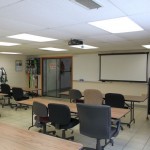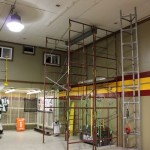Fall Protection Training: Classroom Versus Hands-On
 Here at FallProof Systems, I serve as the primary trainer for our fall protection training classes. Each class I teach is a little bit different. We get all types of workers as students, and their reasons for taking each class often depend on the type of class.
Here at FallProof Systems, I serve as the primary trainer for our fall protection training classes. Each class I teach is a little bit different. We get all types of workers as students, and their reasons for taking each class often depend on the type of class.
To give you a quick overview, the Fall Protection training courses we offer are:
Competent Person Training – This 16-hour course is designed for supervisors, project managers and engineers, and anyone else who needs OSHA Competent Person training for fall protection systems.
Equipment Inspection Training – This 8-hour “in-depth” course is designed for newly-trained competent persons who are responsible for their company’s annual inspections of personal fall arrest systems, and also for tool crib workers who need to inspect equipment before they issue it to the users.
Authorized User Training – This 4-hour course covers the basics of fall protection systems. Our students in these classes include anyone who needs a basic understanding of how to use this equipment. As I like to say, this class is for the people who turn the wrench, or repair the roof, or fix the boiler.
In these courses, I’ve taught everyone from construction workers to aviation maintenance people to all types of general industry workers. Over the past few months, my students have included factory and plant workers from glassware and paper cup manufacturers, transit workers from a local transit authority, and even stagehands from a university theater department. (They need to use PPE while hanging lights and scenery from the catwalks backstage.)
Classroom Training
Our classes begin with class time. In Competent Person Training, for example, our students get a binder manual of course materials. This binder includes in-class Q & A exercises, a reprint of the OSHA regulations section that covers fall safety and prevention, and some fall protection programs that they can take back to use at their company.
We spend a few hours in the classroom, covering the different types of systems and safety equipment. I show our students how to identify and resolve hazards using the REC method (Recognize – Evaluate – Control). We also go through the OSHA fall protection requirements, and look at some statistics regarding deaths or injuries and the cost of worker compensation due to on-the-job accidents.
Some supervisors and managers find the classroom portions of Competent Person Training to be very eye-opening. Many of them don’t realize until they take this class that they need a fall protection and rescue plan in place at their business. Others who take the class find out things they didn’t know about fall protection equipment. (“I didn’t realize you need 18 ½ feet of fall clearance from the anchor point when you’re using a shock-absorbing lanyard.”)
Hands-On Training
 But you can’t really learn how to properly use safety equipment just by reading about it, or listening to someone lecture about it. So throughout the day, we break up each class with hands-on training modules. After I talk about a subject in the classroom, we immediately take our students downstairs to our Training Room, so they can “learn by doing it.”
But you can’t really learn how to properly use safety equipment just by reading about it, or listening to someone lecture about it. So throughout the day, we break up each class with hands-on training modules. After I talk about a subject in the classroom, we immediately take our students downstairs to our Training Room, so they can “learn by doing it.”
Our Training Room includes climbing walls, balconies, and scaffolding of the kind you might find on a radio tower. We show our students how to put on a full body harness, and how to fit it properly. I use a lifting device to pick up each student, so they know what it feels like to hang in the safety harness. We show them how to attach lanyards and self-retracting lifelines (SRLs) to their harness, and let them climb on the training wall to show how the harnesses and lifelines work in a real-world setting.
Our students say this hands-on training is the best part of our classes. It gives them real experience in putting on their own PPE, and helps them understand how the different elements fit together. It teaches them how to ensure their own safety on the job.
For our Competent Person class, we take hands-on training a step further. We show supervisors and managers how to calculate fall distances and clearances, and how to select the right equipment for a certain job. For example, when we demonstrate the use of SRLs and safety lanyards, our students can see why it’s best to use SRLs for low clearance work areas, because lanyards require greater fall clearances.
We also do a simulated rescue, where one of our employees hangs in a safety harness and plays the role of “victim.” Our students then practice a “rescue,” where they learn how to safely lower the victim to the ground.
Overall, the hands-on training gives workers and supervisors far more insight and competence in the use of fall safety equipment than the classroom work alone could provide. Our students come away with a better understanding not only of how the equipment works, but of the importance of fall protection, the need to do it right, and the need to extend these safety precautions to every worker at their business. Moreover, the need for a pre-planned and well-rehearsed rescue becomes apparent when they see the confusion and chaos that arises even in a controlled environment.

